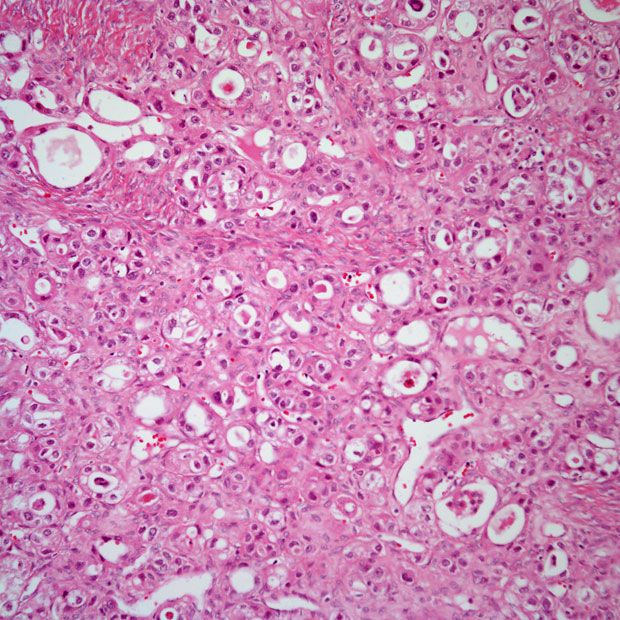HIPEC/Cytoreduction Produces Long-Term Survival in Advanced Ovarian Cancer
The efficacy of HIPEC plus cytoreductive surgery appears to be consistent across ovarian cancer subgroups based on age, histological type, and pre-surgery laparoscopy in the phase 3 OVHIPEC-1 trial.
“These survival benefits were consistent across prespecified and post hoc patient subgroups, although in an exploratory post hoc analysis, patients with homologous recombination deficient tumors without pathogenic BRCA1/2 mutation appeared to derive the greatest benefit of HIPEC as opposed to patients with BRCA1/2-mutated tumors," according to the study authors.

Adding hyperthermic intraperitoneal chemotherapy (HIPEC) to interval cytoreductive surgery yielded an enduring survival benefit compared with surgery alone among patients with primary epithelial stage III ovarian cancer, according to findings from the final survival analysis of the phase 3 OVHIPEC-1 trial (NCT00426257) published in Lancet Oncology.
The median progression-free survival (PFS) was 10.7 months (95% CI, 9.6-12.0) with surgery alone vs 14.3 months (95% CI, 12.0-18.5) with HIPEC in combination with surgery (HR, 0.63; 95% CI, 0.48-0.83; P = .0008). In each respective arm, the PFS rates were 6.6% (95% CI, 3.4%-13.0%) vs 12.3% (95% CI, 7.7%-19.7%) at 5 years and 6.6% (95% CI, 3.4%-13.0%) vs 10.1% (95% CI, 5.8%-17.5%) at 10 years.
Investigators reported a median overall survival (OS) of 33.3 months (95% CI, 29.0-39.1) in the surgery alone group vs 44.9 months (95% CI, 38.6-55.1) in patients who received surgery plus HIPEC (HR, 0.70; 95% CI, 0.53-0.92; P = .011). The 5-year OS rates in each respective group were 19.7% (95% CI, 13.7%-28.0%) vs 36.9% (95% CI, 29.2%-46.5%), and the 10-year rates were 10.9% (95% CI, 6.5%-18.0%) vs 16.1% (95% CI, 10.3%-25.2%).
“With a median follow-up of 10.1 years in the overall study population, this is the first study, to our knowledge, to provide long-term survival data from a randomized trial of HIPEC in primary ovarian cancer,” the study authors wrote. “These survival benefits were consistent across prespecified and post hoc patient subgroups, although in an exploratory post hoc analysis, patients with homologous recombination deficient tumors without pathogenic BRCA1/2 mutation appeared to derive the greatest benefit of HIPEC as opposed to patients with BRCA1/2-mutated tumors.”
In the open-label phase 3 OVHIPEC-1 trial, patients were randomly assigned 1:1 to receive cytoreductive surgery alone (n = 123) or surgery plus HIPEC (n = 122), which consisted of 100 mg/m2 of cisplatin, 3 additional cycles of carboplatin area under the curve 5 to 6 mg/mL per minute, and paclitaxel at 175 mg/m2 body surface area every 3 weeks following surgery.
The trial’s primary end point was PFS, with OS as a secondary end point.
Patients 18 to 76 years old with histologically confirmed stage III epithelial ovarian, fallopian tube, or peritoneal cancer who had not progressed on treatment including 3 or more cycles of neoadjuvant carboplatin plus paclitaxel were able to enroll on the trial. Additional eligibility criteria included having a World Health Organization performance status of 0 to 2, normal blood counts, and adequate renal function.
Investigators reported a median follow-up time of 10.1 years (95% CI, 8.4-12.9) in the surgery alone group and 10.4 years (95% CI, 9.5-13.3) among patients who received HIPEC plus surgery. Based on tests for independence of scaled Schoenfeld residuals and time, the assumption of proportionality of hazards was reached for PFS (P = .71) and OS (P = .31). BRCA1/2 status appeared to influence the impact of HIPEC on PFS (P = .015) and OS (P = .016).
Most patients in the surgery alone group (80%) and the HIPEC plus surgery group (84%) went to receive subsequent treatment with platinum-containing chemotherapy (P = .47). In each respective treatment group, 53% and 44% received subsequent non–platinum-based chemotherapy (P = .19), 15% and 18% received subsequent hormonal therapy (P = .60), and 15% and 15% were treated with subsequent radiotherapy (P = .89).
Reference
Aronson SL, Lopez-Yurda M, Koole SN, et al. Cytoreductive surgery with or without hyperthermic intraperitoneal chemotherapy in patients with advanced ovarian cancer (OVHIPEC-1): final survival analysis of a randomised, controlled, phase 3 trial. Lancet Oncol. 2023;24:1109-1118. doi:10.1016/S1470-2045(23)00396-0
Late Hepatic Recurrence From Granulosa Cell Tumor: A Case Report
Granulosa cell tumors exhibit late recurrence and rare hepatic metastasis, emphasizing the need for lifelong surveillance in affected patients.